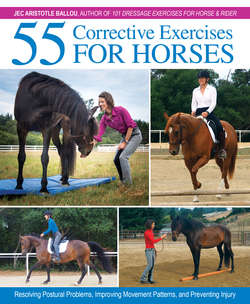Читать книгу 55 Corrective Exercises for Horses - Jec Aristotle Ballou - Страница 13
На сайте Литреса книга снята с продажи.
Understanding Fascia
ОглавлениеA body-wide cloth of fibrous collagen called fascia envelops muscles, nerves, veins, and organs individually, and also connects them all together to form a network. This gauze-like web of tissue determines, in large measure, how a body is able to move. When this tissue becomes disorganized, strained, or dehydrated, its ability to glide across surrounding tissues is impaired. Eventually, this leads to a diminished range of motion in muscles and joints. The fascia adapts to this restricted pattern and spreads it throughout the horse’s entire system. Thus begins a cycle of restriction begetting more restriction.
fit tip
In human medicine, sensory and proprioceptive education has been instrumental in reducing the need for surgical intervention to repair joints in 50 percent of cases. It is logical to extend these findings to horses as well.
Common reasons for fascia tissue losing its glide or pliability include: localized strain, a poorly fitting saddle, injury or inflammation, repetitive movements, and emotional stress. Good muscle function depends on pliability of the fascia, not just for force effort but also for sensory input. The sensory nerves that communicate information back and forth between muscles and the central nervous system reside in fascia. If and when the fascia is altered, these signals about joint position and muscle coordination falter (fig. 1.2).
1.2: When disruptions occur to the health and pliability of the fascia, muscle patterns are negatively altered. If left unaddressed, these can lead to lasting imbalances. A horse will be unable to transmit energy forward from the hindquarters without restriction or resistance (red arrows). Stretches and corrective exercises provide an organizing force (blue arrows) that can realign fibers and movement patterns.
A hydrated and well-trained fascia network plays an enormous role in fitness. Its significance reminds us to not think about training muscles individually, because in reality that is not possible. Through fascia, the horse’s system is interconnected. It is analogous to a T-shirt hanging from a branch. If one part of the T-shirt snags, it will pull on and disturb the alignment of threads farther away from the actual snag. The physical shape of the T-shirt will change and continue to lose form over time.
Exercises that focus too repetitively on the same range or plane of motion can cause the fascia to become excessively sticky and thick, limiting tissue glide. On the contrary, exercises that stimulate proprioceptive adaptations like ground poles, varied surfaces, and alternating forces of effort help improve fascia (see What Is Proprioception? on p. 71). This translates to balance and stability in the body. Therapists call this optimum state a system-wide engagement of the nervous and muscular systems.
